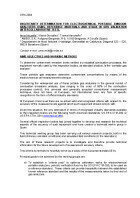Air Monitoring
UNCERTAINTY DETERMINATION FOR ELECTROCHEMICAL PORTABLE EMISSION ANALYZERS USING REFERENCE MATERIALS AND STACK IN SITU VALIDATION (INTERCOLLABORATIVE TEST).
Jul 04 2014
Author: Anxo Mourelle, Mercè González, Txema Mancheño on behalf of CEM
AIMS OBJECTIVES AND WORKING METHODS
To determine contaminant emission levels emitted by industrial combustion processes, the equipment normally used by the inspection bodies, as standard practice, is the “portable gas analyser”.
These portable gas analysers determine contaminant concentrations by means of the electrochemical cell measurement technique.
Considering the widespread use of these potable gas analysers in the general market of combustion emissions analysis, (use ranging in the order of 80% of the combustion processes control), this universal and generally accepted conventional measurement technique, does not have, at European, nor international level, any form of specific recognition in the form of official industry standards.
At European Union level there are no actual valid and recognised criteria with respect to the accuracy of the measured levels against which such equipment should comply with.
Given this situation, the only alternative in terms of recognised industry standards available to the inspection teams are the following North American standards: US EPA CTM-030 or US EPA CTM- 034 (www.epa.gov/ttn).
Several official inspection bodies had joined together to develop and research the technical aspects of the accuracy of such equipment and have created a technical workin group in Spain.
This technical working group has been carrying out various research projects, both in the field (chimney real stack conditions) and simulated field conditions (in the laboratory).
The aim of these research projects is to investigate and therefore provide technical information for the future development of measurement accuracy criteria.
This criteria is intended to hopefully serve as a basis of the european standard (EN).
Principal goals to be achieved by the working groups are:
a) To establish a “criteria pack” to optimize calibration works for electrochemical portable analyzers, periodic verification fixed by the US EPA CTM-030, to be used as a reference standard. These criteria can provide traceability between the established known reference standard and the results of the measurements taken by this kind of gas analyzers.
b) To give sufficient guarantees regarding the quality of the obtained results during the measurements taken during the industrial combustion processes, in accordance with the criteria set by the EN-45004:1995 and EN-17025:2000 standards even of the point of view of the statistics like of the guarantees of the performance characteristics of the analyzer.
c) Calculate under “optimum laboratory conditions” the measurement uncertainty from the results obtained for each of the principal compounds stated in the US EPA CTM 030 standard (SO2, NOx, CO) and also in real plant conditions (stack emission conditions). This uncertainty will be calculated from two intercollaborative tests, in the lab and on site plant determinations.
Digital Edition
AET 28.2 April/May 2024
May 2024
Business News - Teledyne Marine expands with the acquisition of Valeport - Signal partners with gas analysis experts in Korea Air Monitoring - Continuous Fine Particulate Emission Monitor...
View all digital editions
Events
Jul 10 2024 Birmingham, UK
Jul 21 2024 Cape Town, South Africa
Australasian Waste & Recycling Expo
Jul 24 2024 Sydney, Australia
Jul 30 2024 Jakarta, Indonesia
China Energy Summit & Exhibition
Jul 31 2024 Beijing, China















